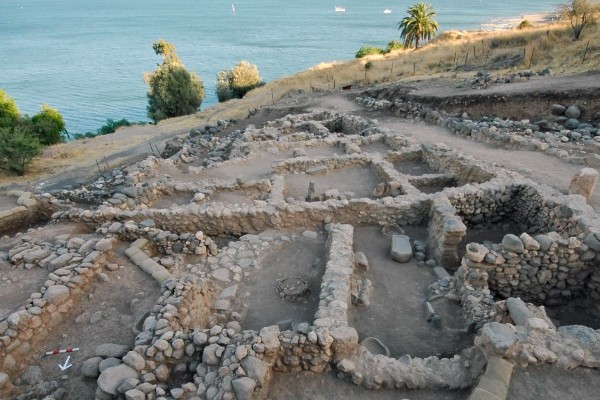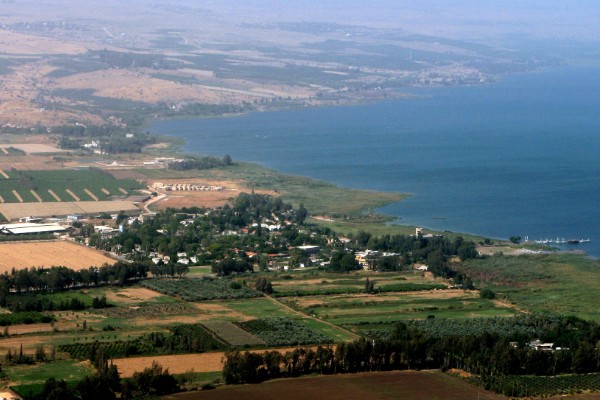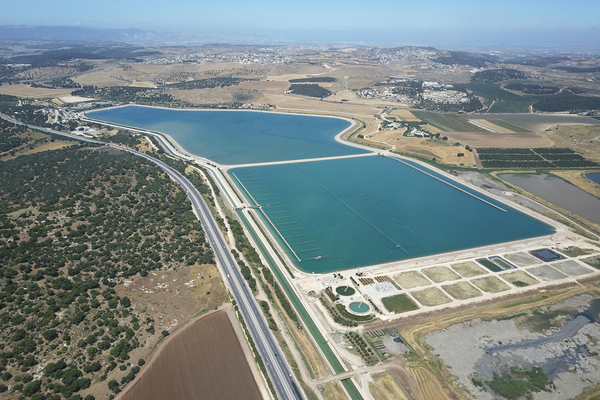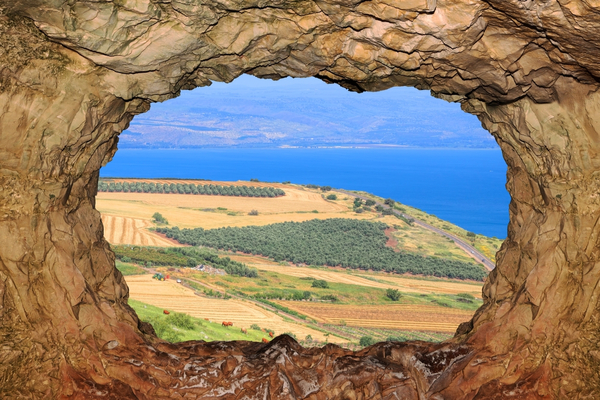
Thanks to uniquely fertile conditions, the produce of Ginosar matures faster.
By Nosson Shulman, Licensed Tour Guide
“And the fortress cities are Ziddim, Zer, and Hammath, Rakkath, and Kinneret.” (Joshua 19:35)
“The country (valley) around (the Sea of Galilee) is also called Ginosar, whose soil is so fruitful, that all sorts of trees can grow upon it, and all trees (both cold and hot climate trees) are planted by inhabitants, which flourishes because the temper of the air is so well mixed, that it agrees very well with all sorts of different fruit trees … a spring from a most fertile fountain waters here so much so that people think it is the vein of the mighty Nile.” (Josephus)
Today we are visiting a site of paramount beauty and an important place in Biblical times, the town of Kinneret and the fertile fields of Ginosar (a.k.a. Gennesat) surrounding it.
Although Ginosar remains one of the most fruitful places in the country, the ancient ruins of Kinneret have all but been forgotten (although in actuality, this site is arguably the MOST significant place in the entire state of Israel with regards to natural security concerns). Very few people are aware of its existence and even fewer visit.
But those who do visit are rewarded with breathtaking views (including the Sea of Galilee). It has a visibly rich past and is also beautifully aromatic!
The site (which was fortified) was first settled in the early Canaanite period (circa 3rd Millenia BCE) making it one of the oldest sites in the country.
When Joshua brought the children of Israel into the Holy Land, the inhabitants of Kinneret unsuccessfully fought against the Jews (see Joshua 11:2). Joshua’s army captured the city, gave it to the tribe of Naphtali (see Joshua 19:35) and made the city into a booming metropolis, having the thickest city walls ever found in Israel (12 meters or 39 feet).

A view from the top of Biblical Kinneret, which is situated on the Sea of Galilee. The ruins are from the Israelite period when the city was a booming metropolis! (Kinneret Regional Project via Nosson Shulman)
What circumstances allowed this city to flourish in Biblical times?
Firstly, it was strategically located on the ancient highway connecting Egypt and Mesopotamia (Assyria, Babylonia, etc.) the world’s leading superpowers of that time. Controlling this road meant having a certain level of control over international trade.
Additionally, Kinneret sits on the Sea of Galilee (in fact, this important town gave its name to the Sea as even today, the Sea of Galilee is called “Kinneret” in Hebrew). The north-eastern part of the Sea (where Kinneret was located) is warmer due to geo-thermal springs that flow into it, making this the part of the sea that has the richest sea life (which made this region a major player in the fishing industry. For example, Magdala, a nearby town, became very wealthy from the fish trade.
The number one factor that made this city a desirable, wealthy, location were the extremely fertile fields of Ginosar that surrounded the town.
Even today, the soil here is among the most fertile in the entire Middle East, particularly for fruit. Indeed, according to Jewish sources, the reason why the town (and subsequently the sea itself) got the name Kinneret, is because the fruits of Ginosar (which surrounded the town) are as sweet as the sound of the harp (Kinnar is Hebrew for harp).
Due to the excellent climate and great soil of this area, all types of fruit grew here in ancient times (flourishing in hot, cold, or temperate climates). Jewish sources laud the greatness of these particular fruits (which are compared to the fruits of the Garden of Eden!).
The fruits of Ginosar matured a full month faster than fruits of other fields. According to Jewish sources, this is connected to the blessing which Jacob (on his deathbed) gave his son Naphtali that he is a “swift gazelle” (see Genesis 49: 21). This refers to the valley of Ginosar (found in Naphtali’s territory) which ripens its fruits swiftly, like the gazelle.

Some of the fields of nearby Kibbutz Ginosar. Banana groves, date farms, mangos and olive orchards can be seen. (Wikimedia Commons)
The city of Kinneret was later destroyed by Ben Haddad, King of Aram (based in Damacus) after King Asa of Judah bribed him to destroy it (1 Kings 15:20). It was subsequently rebuilt, then destroyed again by Assyrian King Tiglath-Pileser III approximately 2600 years ago. Since then, aside from a small town that existed here during the Hellenistic period, the town has been almost completed abandoned and forgotten.
However, in 1964 Tel Kinneret became arguably the biggest national security concern of the State of Israel because of water.
Since Biblical times, water has often been an issue in this Middle Eastern country (the fact that all of Israel has 24/7 running water is nothing short of miraculous. Israel’s next-door neighbors including most of Jordan, do not have that level of access). The Sea of Galilee is Israel’s only freshwater “lake” and was Israel’s main source of drinking water.
In 1964, as Israel’s population was growing, the national water carrier was built to bring water from the Sea of Galilee to the rest of the country (including Israel’s towns in the southern Negev desert).
However, the Golan Heights (which overlooks the Sea) was occupied by Syria, which was trying to destroy the state of Israel. Attempts had been made in earlier years to cut off Israel’s water access by any means, and all Syria had to do was shoot a missile at the high-tech pumping station (which after 58 years is still considered cutting edge).
In order to protect the pumping station from Syrian fire, it was built underneath (the long abandoned) ruins of biblical Kinneret. In 1967 Israel liberated the Golan Heights, making direct fire no longer an issue. The water level of the Sea of Galilee is still of utmost importance and the National Water Carrier system is actively protected from enemies who are constantly trying to find ways to “pollute” the water. (As an example, Iranian hackers tried to add dangerous amounts of chlorine into Israeli water infrastructure.)

The Eshkol Treatment Plant, where most of the water piped from the Sea of Galilee is brought for treatment before being sent to the rest of the country. (Shutterstock)
According to Jewish sources, in the end of days in the battle between Gog and Magog, the casualties from Gog will be buried (near Tel Kinneret) in the Valley of Ginosar (see Ezekiel 39:11).
On your next trip to Israel, I highly recommend visiting this luscious valley!
Nosson Shulman is a journalist and Licensed Tour Guide in Israel specializing in Biblical tours. To allow tourists to experience Israel during the Corona era, he created the new hit Israel tour video series, which brings Israel to the home of viewers by simulating actual tours. To check out his free sneak preview tour videos, click here. To view sample tour itineraries or to inquire about private tour opportunities with a personalized itinerary on your next trip to Israel, click here.
Bring Purim Joy to Israeli Victims of War and Terror
Join us in providing Israeli victims of war and terror with much needed comfort, blessing and holiday joy.
Families have been destroyed by the horrific Hamas massacre of October 7th and ongoing terror and rockets attacks. There are so many orphans that need our love, compassion and support!
Brighten their Purim holiday by sending Purim food baskets, yummy treats, personal notes and toys for the children.
CLICK HERE TO SEND YOUR PURIM GIFT & PERSONAL NOTE TO THE VICTIMS




